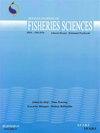黄鳝幼虫和幼鱼消化系统的个体发育
IF 0.6
4区 农林科学
Q3 FISHERIES
引用次数: 0
摘要
采用光镜、血红素-伊红染色和电子显微镜对黄鳝幼虫和幼鱼的胃肠道发育进行组织学分析和口腔发育扫描。本研究主要通过对黄颡鱼幼虫口腔生长和消化道的形态学和组织学研究,根据黄颡鱼幼虫的形态学分级,探讨为其提供实用饲料的最佳断奶时间。观察发现,在孵化后第5天,幼虫张开了嘴巴。第八天,卵黄囊被吸收了三分之二。在同一天,食物是人工喂养的。第10天卵黄囊完全吸收。食管的组织学基础在第3天形成。第3天,肠细胞开始形成。第5天幼虫肝胰脏形成。结果表明,8天后,这些鱼的幼虫可以有适当的饮食。在这一天,口的大小为84µm。当口腔角为45°和90°时,20 d内形成的口腔食物尺寸分别为168 μm和307 μm。本文章由计算机程序翻译,如有差异,请以英文原文为准。
Ontogenetic development of the digestive system in Alburnus chalcoides larvae and juveniles
The growth of the gastrointestinal tract of the larvae and juvenile of Alburnus chalcoides was studied after histological analysis using light microscopy, haematoxylin-eosin staining and the mouth development was scanned via electron microscopy. This study focuses on the morphology and histology of the mouth growth and digestive tract of A. chalcoides larvae to test the best weaning time for providing practical diet for fry based on the grade of their morphological aspects. It was observed that on the fifth day after hatching, the larvae mouth was opened. On the eighth day, the yolk sac was absorbed by two-thirds. On the same day, food is fed manually. Yolk sac was completely absorbed in 10th day. The histological base of the esophagus was formed by day 3. At day 3, the formation of enterocytes started. Also, the larvae hepatopancreas was formed on 5th day. According to the results, it was observed that after 8 days onwards, larvae of these fish can have a proper diet. At this day, the size of the mouth was 84 µm. when the lips were formed within 20 days and for the mouth angles 45oand 90o, the food size for mouth, was 168 and 307 μm, respectively.
求助全文
通过发布文献求助,成功后即可免费获取论文全文。
去求助
来源期刊

Iranian Journal of Fisheries Sciences
FISHERIES-
CiteScore
2.30
自引率
11.10%
发文量
0
审稿时长
3 months
期刊介绍:
1- Living various species (contains animals and vegetal species) in various aquatic ecosystems.
2- Health and diseases of aquatic species.
3- Determining the stocks and specific time and location for catching and reliable exploitation for sustainable development.
4- Methods of propagation and culture of high value aquatic resources.
5- Aquatic stock assessment and the methods of restocking the high value species and suggestion for rate, areas and the time for releasing fish and other aquatic organisms fries.
6- Pollutant agents and their effects to the environments of aquatic species.
7- Feed and feeding in aquatic organisms.
8- Fish processing and producing new products.
9- The economic and social aspects of fisheries.
 求助内容:
求助内容: 应助结果提醒方式:
应助结果提醒方式:


